Description
Projects are not just about tasks, deadlines, and budgets. They are about turning ideas into real results that help an organization move forward. In today’s fast-changing world, traditional project management is often not enough. Success requires strategic thinking. This means connecting projects directly to organizational goals, planning carefully, and staying flexible when conditions change. Terry Schmidt’s Strategic Project Management Made Simple provides a simple, practical guide to help managers and teams approach projects with a strategic mindset.
The book begins with the idea that projects work best when built on a solid foundation. To achieve this, Schmidt introduces a clear way of structuring goals, outcomes, outputs, and activities. Think of it as a logical flow: you start with the big picture goal, then narrow down to the purpose of the project, the concrete outputs to be delivered, and finally the day-to-day activities needed. This structured approach ensures that everyone knows not only what they are doing, but also why they are doing it. It prevents confusion and helps avoid wasted effort.
Stakeholders play a crucial role in any project. These include team members, leaders, customers, partners, and sometimes even people who may resist the project. One of the book’s strongest points is the emphasis on involving stakeholders early and often. People support what they help create. When stakeholders are invited into the planning process, they feel a sense of ownership. They are more likely to stay committed, contribute resources, and help resolve issues. Ignoring or overlooking stakeholders can lead to resistance, delays, and even project failure. That is why Schmidt advises building trust and communication with them from the very beginning.
Once stakeholders are on board, the next step is defining objectives clearly. Many projects fail because the objectives are too vague or overly ambitious. Schmidt suggests asking the most basic but essential question: What are you trying to accomplish, and why? By digging deeper into the “why,” teams can uncover the real problem to solve and ensure that their efforts make a difference. Objectives should be specific, measurable, and connected to larger goals. For example, instead of simply saying “improve sales,” a project objective could be “increase product adoption by 20% within six months.” Such clarity makes it easier to design the right activities and measure results.
Speaking of measurement, the book stresses the importance of tracking progress. It is not enough to just complete tasks; the results must be meaningful. For this, Schmidt encourages creating indicators at every level. At the highest level, these might measure company growth or market share. At the project purpose level, they show whether customer behavior or employee performance has improved. At the output level, they check whether deliverables meet quality standards and deadlines. At the activity level, they track whether tasks are completed on time and within budget. The key lesson is to measure what really matters, not just what is easy to count.
No project exists in a perfect bubble. External conditions, risks, and assumptions always play a part. A project might assume that funding will continue, that technology will work as expected, or that customers will adopt a new system. But if these assumptions turn out to be wrong, the project may struggle. Schmidt suggests making these assumptions visible from the start. Teams should write them down, check their likelihood, and prepare backup plans for the most risky ones. By addressing assumptions upfront, teams reduce surprises and increase their ability to adapt.
With goals defined, stakeholders engaged, and assumptions identified, the question becomes: How will you actually get there? Here Schmidt emphasizes planning in chunks or phases. Instead of trying to map out every detail from the start, he recommends focusing on near-term steps while leaving room for adjustment later. This way, teams can act quickly while staying aligned with long-term goals. Planning tools like work breakdown structures, schedules, and responsibility charts are useful here. Each activity should connect back to outputs, purposes, and goals. This ensures that no task is wasted and every effort contributes to the bigger picture.
Even with careful planning, reality often changes. That is why flexibility is a key theme of the book. Schmidt introduces the idea of learning cycles—monitoring progress, reviewing strategies, and evaluating results. Monitoring means checking whether activities are producing outputs as expected. Reviewing means stepping back to ask whether the project is still on track to achieve its larger purpose. Evaluating happens at the end, when the team looks at whether the project made a real impact. These cycles help teams adjust quickly, learn from mistakes, and apply lessons to future projects.
Another valuable insight is that project managers should act less like task supervisors and more like navigators. A navigator does not just follow a map; they constantly check conditions, correct course, and make sure the destination is reached. Similarly, strategic project managers need to guide their teams through uncertainty, adjust to obstacles, and keep everyone aligned with the mission.
The strength of Schmidt’s approach lies in its simplicity. By focusing on four big questions—What are you trying to accomplish and why? How will you measure success? What conditions must exist? How will you get there?—any project can be structured clearly and logically. These questions cut through complexity and provide a framework that teams can use again and again.
The book also highlights the importance of communication. Plans, measures, and assumptions are useful only if everyone understands them. Clear communication builds alignment and prevents misunderstandings. Whether it is through team meetings, written reports, or simple visual frameworks, project managers should make sure that information flows smoothly.
In the end, Strategic Project Management Made Simple is not about adding complicated tools or layers of control. It is about clarity, alignment, and adaptability. Projects succeed when they are tied to meaningful goals, when stakeholders are engaged, when progress is measured carefully, and when teams are flexible enough to learn and adapt. Schmidt’s method provides a practical path for achieving this.
To sum it up, the book teaches us that strategy and execution are not separate things. They must work together. Projects are the bridge between vision and reality. By asking the right questions, planning carefully, and staying flexible, any project can become a powerful driver of real results.





